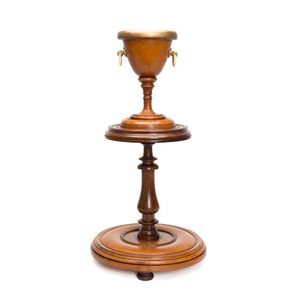Tasmanian Wood and Whalebone Centerpiece
You must be a subscriber, and be logged in to view price and dealer details.
Subscribe Now to view actual auction price for this item
When you subscribe, you have the option of setting the currency in which to display prices to $Au, $US, $NZ or Stg.
- Casuarina - Casuarina, is also known as beefwood (because of its appearance) she-oak, swamp oak, river oak, forest oak and Botany Bay wood. It is a native Australian hardwood, red brown in colour with dark flecks.
- Huon Pine - Named after the Frenchman who discovered the Huon River in Tasmania, it is an extremely slow growing and long living tree. Huon pine is native to Tasmania, and it can grow to an age of 3,000 years or more. The wood contains oil that retards the growth of fungi, hence its early popularity in ship-building in convict-era Tasmania. The timber is a warm yellow colour, finely grained, and was popular for household furniture in the Victorian era. Interestingly, much Huon pine furniture was made in South Australia. Huon pine is a protected species and only limited quantities are available nowadays, for craftsmen to manufacture small items such as platters, sculptures and other decorative objects.
- Blackwood - One of the best known and most widely used Australian timbers, blackwood (acacia melanoxylon), is a member of the Acacia (wattle) family and grows in eastern Australia from about Adelaide in South Australia, as far north as Cairns in Queensland.
The largest, straightest and tallest trees come from the wet forest and swamps of north-west Tasmania where it is grown commercially.
Blackwood timber colours range across a wide spectrum, from a very pale honey colour through to a dark chocolate with streaks of red tinge.
The hardwood timber has been commonly used in the production of furniture, flooring, and musical instruments in Australia from the late 19th century. However, the straight grain timber is not the most prized or valuable, that honour falls to blackwood with a wavy, fiddleback pattern, which is used both in the solid and as a veneer. Fiddleback was only used on the finest examples of furniture.
This item has been included into following indexes:
Visually similar items

A cedar circular occasional table with platform base and baluster shaped column, circa 1845, 65 cm high, 53 cm diameter

The 1985 Foster's Melbourne Cup, 18ct gold, Fortuanato Rocca for Hardy Brothers, won by What A Nuisance, (3), modelled as a three handled loving cup supported on a tapering stem terminating in a stepped circular foot, resting on a turned blackwood (Acacia

An English Orrery, Devon Clocks Ltd, circa 1960, Mechanical spring driven orrery with dome. Gilt brass plates mounted on chalice base. Eight day going barrel movement with platform escapement, no. 907/1500, 45 cm high, 19 cm diameter

Antique mahogany apprentice pedestal table, diameter 21 cm, height 15 cm approx
